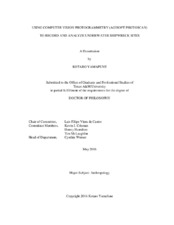| dc.description.abstract | In 2010, a new off-the-shelf software for Computer Vision Photogrammetry, Agisoft PhotoScan, became available to nautical archeologists, and this technology has since become a popular method for recording underwater shipwreck sites. Today (2015), there are still active discussions regarding the accuracy and usage of Computer Vision Photogrammetry in the discipline of nautical archaeology. The author believes that creating a 1:1 scale constrained photogrammetric model of a submerged shipwreck site is not difficult as long as archaeologists first establish a local coordinate system of the site. After creation of a 1:1 scale constrained photogrammetric model, any measurements of the site can be obtained from the created 3D model and its digital data. This means that archaeologists never need to revisit the archaeological site to take additional measurements. Thus, Computer Vision Photogrammetry can substantially reduce archaeologists’ working time in water, and maximize quantity and quality of the data acquired.
Furthermore, the author believes that the acquired photogrammetric data can be utilized in traditional ship reconstruction and other general studies of shipwrecks. With this idea, the author composed a new methodology that fuses Computer Vision Photogrammetry and other digital tools into traditional research methods of nautical archaeology. Using this method, archaeologists can create 3D models that accurately represent submerged cultural heritage sites, and these can be used as representative archaeological data. These types of representative data include (but are not limited to) site plans, technical artifact or timber drawings, shipwreck section profiles, georeferenced archaeological information databases, site-monitoring systems, digital hull fragment models and many other types of usable and practical 3D models. In this dissertation, the author explains his methodology and related new ideas. | en |


